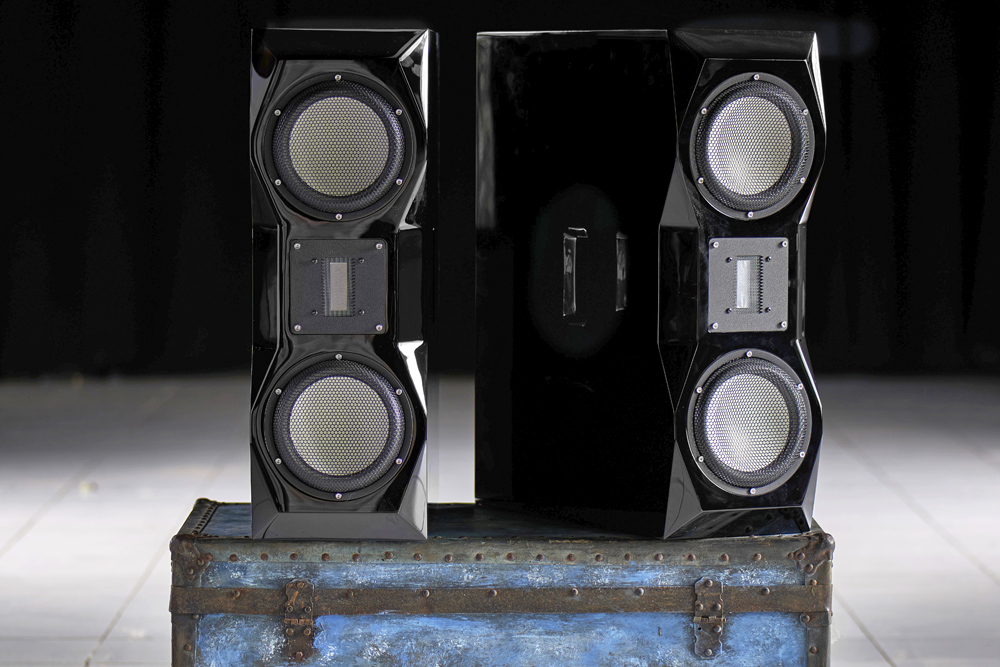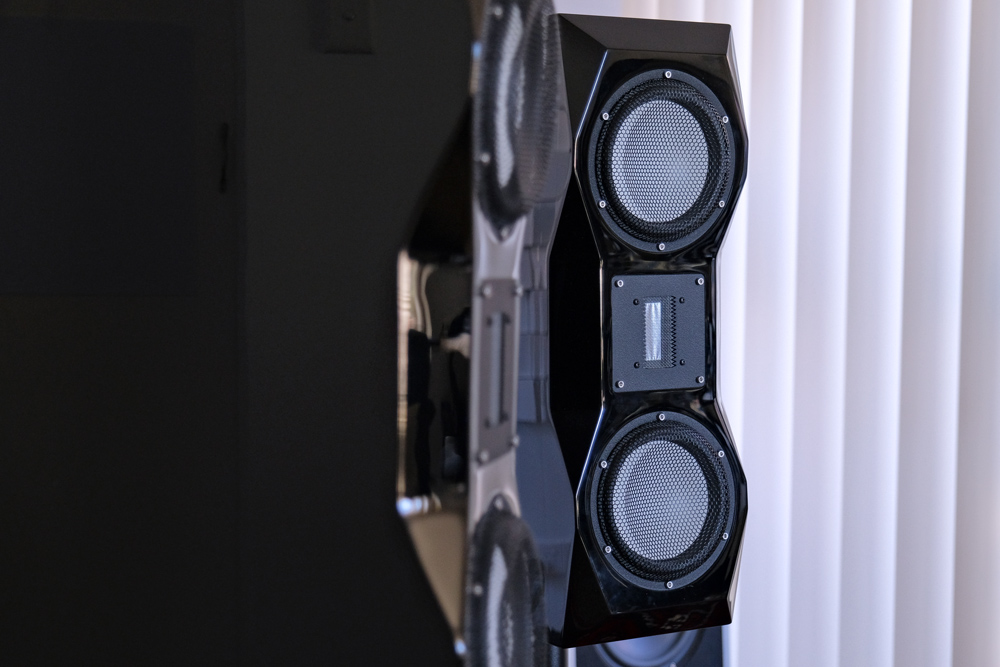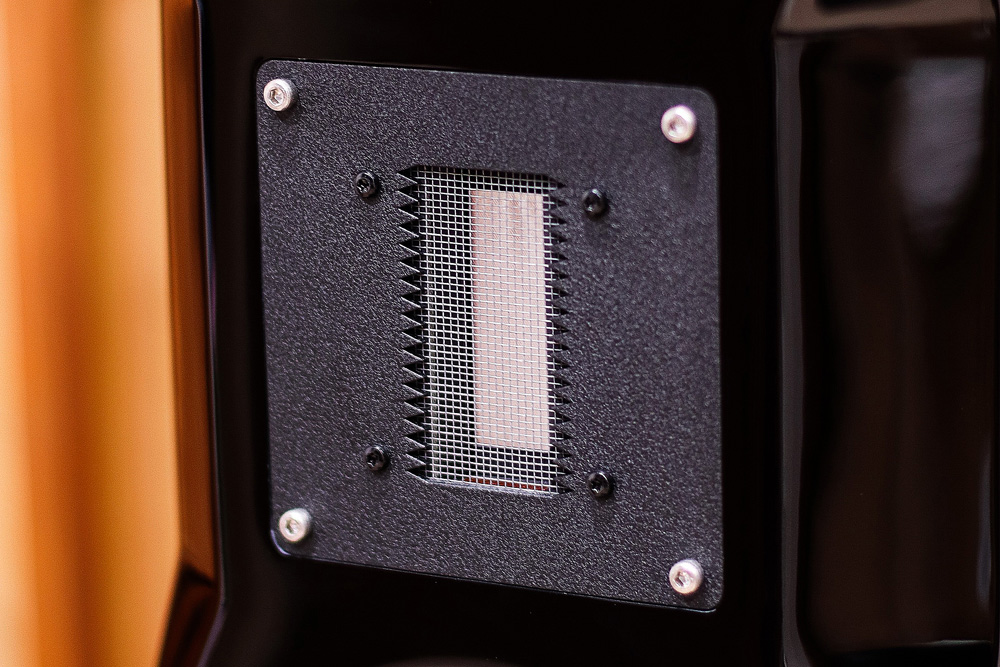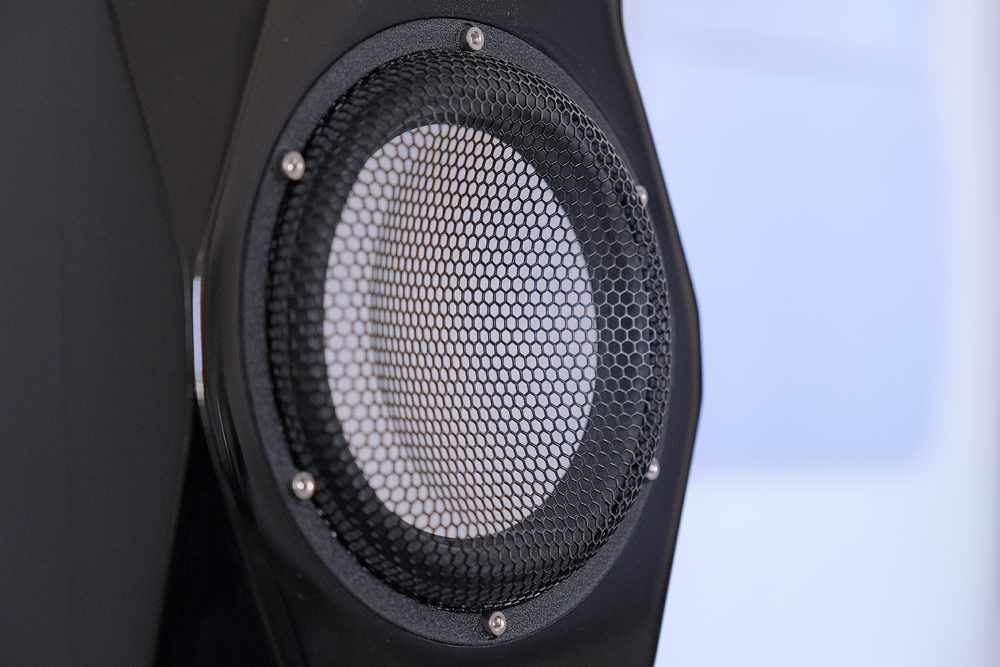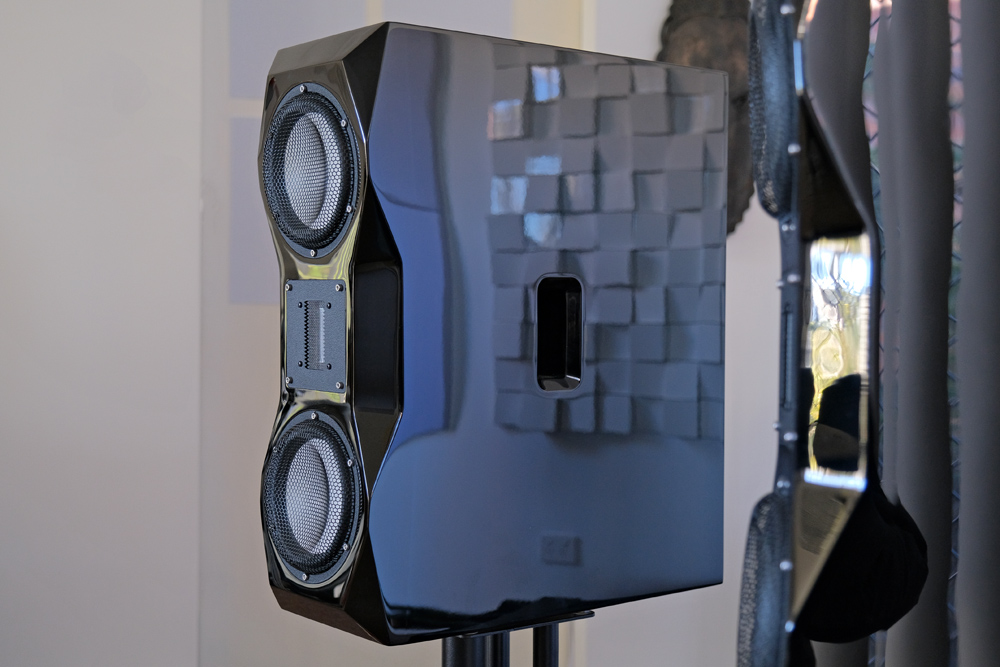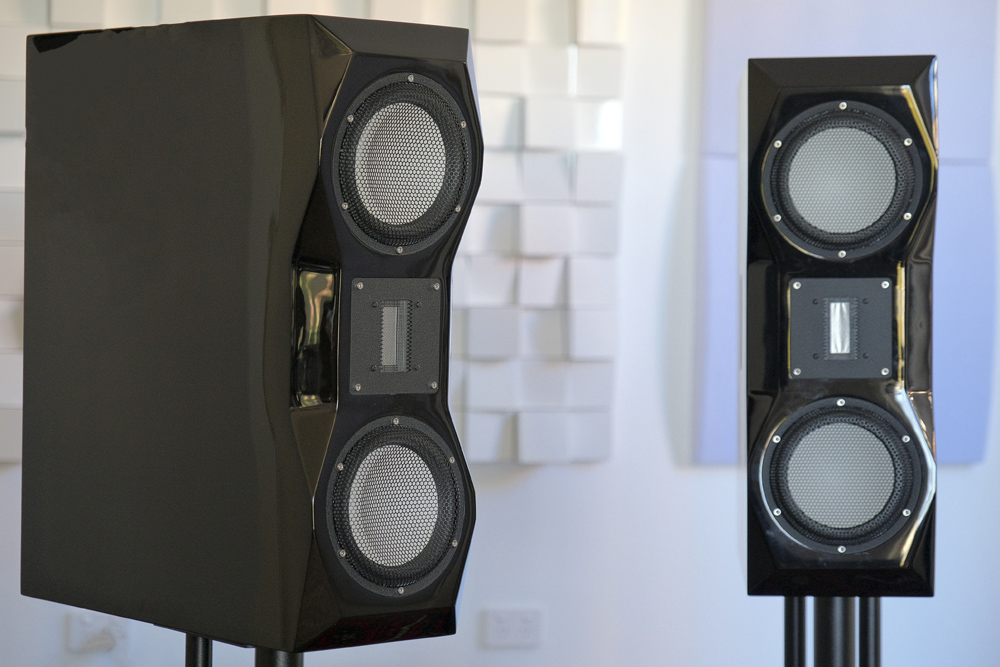A few years ago, for another publication, I reviewed a pair of studio monitor speakers which bridged the divide between the professional and consumer spaces. This super-accurate speaker from Australian company Grover Notting managed to provide both a forensic tool for the studio and a musically involving sound capable of pleasing the discerning audiophile. Much time has passed since that delightful encounter. Now, I find myself once again assessing a loudspeaker design with the balance to adeptly surf the swells between the studio and the home.
Bali Ha’i
The Vermouth Audio Studio Monitor resembles a number of consumer loudspeakers using the D’Appolito configuration of central tweeter embraced by twin mid-bass drivers. In Vermouth Audio’s design, there are strong physical resemblances with, for example, Wilson Audio’s classic CUB (Center Unitized Bass). Aside from the very different high frequency driver (the American an inverted dome, the Studio Monitor a RAAL ribbon tweeter), the driver array and mid-bass transducer size are the same. There are strong similarities in the cabinet dimensions and the careful baffle effect/dispersion measures around the tweeter too. In the Studio Monitor’s case, rather than acoustic foam, acute lateral angling around the ribbon tweeter almost negates the baffle’s influence altogether. Ditto for the unusual reflex venting arrangements, where the American had twin narrow forward-firing baffle slots and the Balinese a single side-firing rectangular chamfered port.
Comparisons aside, the Studio Monitor is very much a non-cookie-cutter design imagined by creative minds, expressed by talented engineers and crafted by skilled artisans. I experienced these very same values when reviewing Vermouth Audio’s Little Luccas Mk II Limited Edition loudspeakers (review here). Again, an outstanding and truly individual design far removed from run-of-the-mill standmounts.
Another aspect of the Studio Monitor’s individuality stems from its source location. No, it’s not the USA, the UK, Germany, France or even Australia. Of course, good ears, solid engineering and quality craftsmanship are universal capabilities and, either despite or because of more established companies, many new quality players are emerging from around the globe robustly expressing their creativity. Power to them.
So, the Studio Monitor springs from Bali, that paradise where company founder and designer Hendry Ramli is steadily expanding his product portfolio from superbly-made, high-value and way-over-performing cable systems to a growing stable of loudspeaker designs, the last couple of which are aimed at both the consumer and professional studio markets (and available in passive or active versions). The Studio Monitor is the middle child of the family, with its smallest sibling a half-version Mini Studio Monitor and the floorstanding extension by way of an upcoming 12 Year Anniversary Edition loudspeaker. Vermouth Audio also offers an improvement path for the Studio Monitor via a number of ‘Upgrade’ levels starting from 1 to 4. The upgrades vary between levels and include a mix of enhanced crossover network components, higher quality internal cabling and re-voicing. Our review samples were in ‘Upgrade 3’ guise priced at US$14,145 and the penultimate wrung up the ladder to the ‘Upgrade 4’ summit.
While I’ll be describing many of the Studio Monitor’s features and overall make-up a little further down, I first wanted to convey Hendry Ramli’s views and insights into the making of these impressive loudspeakers. Being classed a ‘Studio Monitor’ I was curious as to the direction the company may be taking. I asked Ramli about the goals he wanted to achieve with the Studio Monitor speakers aside from the accuracy requirements of a true monitor.
Fundamentally, the primary design objective was to understand what could be created in regards towards technical and creative aspects that audio engineers and music lovers are lacking in the present selection available on the market. We reached out to a selection of engineers, whose talents and portfolios, as well as interests into researching, were symbiotically aligned with our own goals of making a studio monitor series that would greatly enhance workflow, all while being sonically a step above.
Truth be told, it turns out that audio engineers are fickle folk, truly passionate and temperamental, as any artist should be! Engaging them within a project that looks at all the elements of existing studio monitors, from the component level up, while trying to explain the inherent limitations of their own favourite tried-and-trusted studio monitors wasn't a task for the faint of heart.
Of course accuracy in frequency reproduction is paramount, but what is on paper only is half the story of how the mind perceives sound. There are so many elements and adjectives that can be used to try and describe this phenomenon, but simply put, time and time again, the first impression of Vermouth's Studio Monitor series is, quite frankly "I don't like this" and depending on the person, 30 minutes or three days later, "I can't listen to other monitors anymore". They go on to explain how a major aspect of audio engineering is a form of imagination, as a painter would require to mix his colour palette or composition, to achieve the final landscape's result and now they feel that, with the V3 series, imagination is less of guess work concerning the interaction of frequencies. It allows more energy to be focused towards creativity... Which unto itself is the foremost goal, studio monitors or anything else.
Was your design approach to the Studio Monitor totally different to the Little Lucas speakers?
Yes, in Studio Monitor I have a different segment market also higher price range therefore it allows me to work with more and better components to achieve the design goal.
Unusually, the Studio Monitor has its reflex port on the cabinet side. What were your ideas behind this?
For a studio application, placement can be very limited and sometimes the speakers are required to be close to the back wall. So to avoid the associated problems I moved the port to the cabinet side. I don't want the port to be at the front because it ruins the appearance.
Can you tell me about the way you designed the cabinet? Wall thickness, bracing, etc. Aside from the side port, are there any tricks to the cabinet design?
The cabinet is heavily braced for enclosure rigidity and also features a separate chamber for the passive crossover network or a DSP active amplifier. The baffle material is 50mm MDF, the side panels are 25mm MDF and the back, top and bottom panels and bracing are 18mm.
What about range expansion via Pro/Consumer designs to come?
Yes, later I will have a Mini Studio Monitor (passive) and V3B (active) a 10 year anniversary design with the port on the top side for placement flexibility in the studio. There will also be a Micro Studio Monitor (passive) and V3C (active) which is totally the same design as the Mini Studio Monitor but with a smaller 5 inch mid-woofer.
The Studio Monitor’s cabinet felt solid and impervious to obvious resonance from the ole’ knock test. Said cabinet is also beautifully finished in a very high grade black gloss. So, as mentioned above, the Studio Monitor is a reflex-ported 2-way featuring a three-driver array in a D’Appolito configuration. Central to the design – figuratively and physically – is the high quality RAAL 70-20XR ribbon tweeter. RAAL claims the 70-20XR is the smallest “true ribbon” tweeter available today. It’s able to handle high power situations and is said to be very reliable, qualities appreciated both in the studio and in the context of high-end consumer systems.
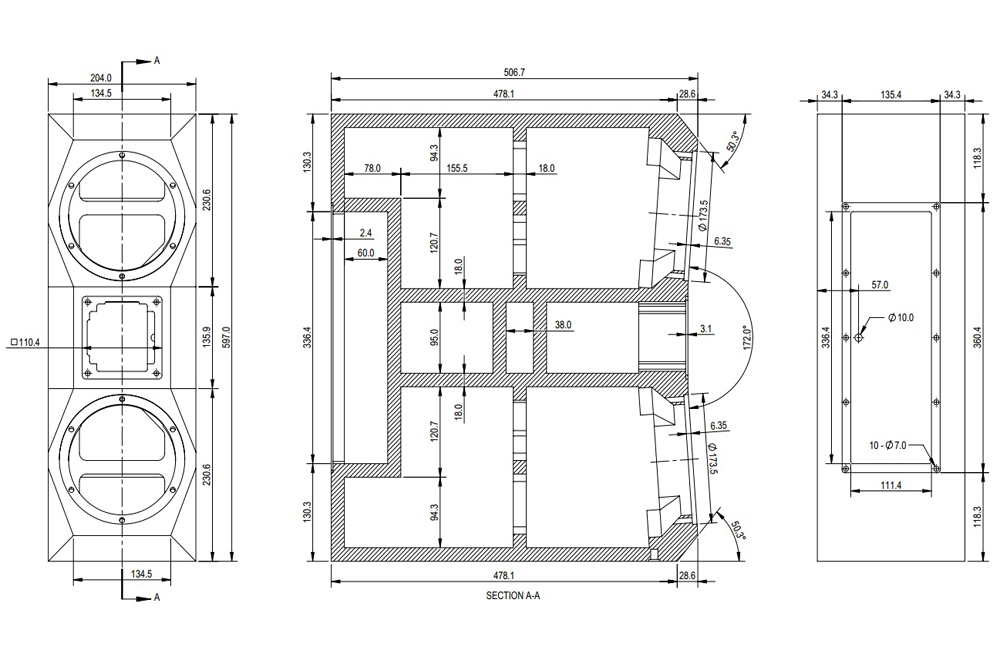
According to RAAL, the 70-20XR is markedly different to its other tweeters. It is only offered to manufacturers under the exclusivity of special arrangements to companies which “… were looking for a quantum leap in true ribbon design.”
Vermouth Audio crosses the tweeter at 1.75 kHz. RAAL specifies an acoustical and electrical point at 1.8 kHz, so Vermouth Audio is blending the drivers in a marginally tweaked fashion. The rather special tweeter then crosses over to twin Accuton C173 165mm ceramic mid-bass drivers. The C173 drivers eschew the trademark dual resonance-control circular perforations of previous designs and deals with that issue at the cone production stage. An oxidation process produces an ‘interface’ towards the centre of the membrane, with a natural resonance-control intersection created at the boundary point.
Vermouth Audio states the Studio Monitor’s frequency response as 44 Hz to 50 kHz +/-3dB with a -10dB bass extension at 33 Hz. Sensitivity is quoted as 89dB at 1 watt/1m/1 kHz while the system impedance is said to be 8 ohms nominal with a minimum point of 6.2 ohms at 140 Hz. On paper, the sensitivity and impedance numbers would point at a reasonably easy load for any well-designed valve amplifier (flea-power SETs aside), with solid state units having a cruisy time driving the Studio Monitors. Apropos, Vermouth Audio recommends an amplifier with a minimum of 50 watts capability.
The crossover point, as stated above, is set at 1.75 kHz, with said crossover network enjoying “premium” components. Our ‘Upgrade 3’ review samples feature several enhanced network components by way of Jantzen & Jupiter capacitors (in lieu of another combination). Internally, the drivers and crossover interfaces are Vermouth Audio’s own high quality cabling. A set of Vermouth Audio tellurium/copper/rhodium-plated speaker binding posts are mounted on a brushed aluminium plate featuring a serial number and the words “carefully handcrafted in Bali”. Unusually, the Studio Monitor features a side-firing reflex port positioned there in order to make placement less critical. A sharp and deep chamfer/mitre around the port’s circumference prevents air turbulence and ‘chuffing’ noise.
As hinted above, the very well-made enclosure is multi-faceted on the baffle around the drivers in order to provide controlled dispersion. The baffle is barely wider than each of the drivers, even around the tweeter’s wide metal face plate. The top and bottom panels are also angled down/up with cut-aways inwards where they meet the baffle in order to minimise reflective surface areas. I actually really liked the symmetrically-sculpted, chiselled looks of the Studio Monitors. Build and assembly quality all-round, and in typical Vermouth Audio fashion, is world-class (for example, take a look at even the entry level cables in the flesh for indisputable evidence).
Details make perfection and perfection is not a detail – Leonardo Da Vinci
Do you want detail? And I mean real detail, not over-emphasised, etched detail like the type which artificially bumps-up the high frequencies in order to sound more overt. The kind of detail that provides true insights into the recording and, as a by-product, offers musicality too. Well, the Studio Monitor’s exceptional RAAL ribbon, in cahoots with the Accuton ceramic drivers, provides you with impeccable information and nuance. Given all the musical data on offer, not once did I hear objectionable brightness or artificiality. Live up to the name much?
Yet, that tweeter is not just a giver of detail. It truly is one of the best I’ve heard in also presenting that ethereal sense of ‘air’ we audio writers often make reference to. It’s by way of an extended shimmer to cymbals and bells which carries on through the upper-range harmonics in a way that enhances the ambience in well-produced recordings. The sparkle in the cymbals and bells in “Train Song” from Holly Cole’s Tom Waits covers album Temptation had a precise initial transient which then tinkled with harmonic and timbrel content and, finally, gradually petered to a slow, fading decay. And when the low, low bass kicks-in the Studio Monitors deliver surprising heft and depth.
That last point was illustrated most perceptibly on Björk’s “Hyperballad” from her Post release where the bass beats which drive the track’s rhythm pounded with satisfying authority. The Studio Monitor’s powers to dissect complex music and yet to maintain the musicians’ intent is superb, as it should be for any speaker with the word “Monitor” in its designation. Björk’s vocals in dense mixes like the track “Army of Me” were well-discernible and in relief of the intricacies of the electronica and drum stream.
On Art Blakey & The Jazz Messengers’ classic Moanin’, the title track had Lee Morgan’s trumpet projecting a tad forward in relation to the other instruments. While this was not objectionable in any way, in terms of an overly bright presentation, it gave the impression of almost hyper realism. For many listeners seeking excitement, this is a good thing (the closer to realism the better, right?). Here, there’s no disputing the completeness of detail and resolution, once again displaying the tenacity of the Studio Monitors to present the captured music in its complete glory. There’s also no lack of dynamic expression, with the speakers providing a generous juxtaposition of gentle nuance and brutal crescendo.
When you’re blending a stunningly-good ribbon tweeter like the on-board RAAL with renowned super-light ceramic drivers from Accuton you can expect lightning fast transient attack. Ah… yeah. Coupled to the extraordinary levels of detail I’ve mentioned above, is an attacking leading edge to notes which enhances the rhythmic qualities of rock and groovy Jazz. Again on Moanin’, Art Blakey’s kit will floor you. On “The Drum Thunder Suite”, Blakey’s playing shows stunning power and subtlety at the same time. There’s a sharp jolt to the drum hits, whether snare, tom or cymbal, which heightens the illusion of a kit in the room.
The Studio Monitors handled superbly the intricacies of the cello and violin. On Vivaldi’s Concerto For Cello (Claude Starck, Kölner Kammerorchester with Helmut Müller-Brüll conducting) in Schwann Musica Mundi’s excellent German-pressed LP and with the massed violins on Sergiu Comissiona (my uncle as it happens) conducting Dvorak’s Symphony № 8 in G, Opus 88 with the Houston Symphony Orchestra, the purity of the Studio Monitors’ driver and crossover combination delivered all the nuance of bow and rosin while also juxtaposing the immensity of both works when the orchestras fire-up. It’s impressive scaling for a standmount monitor and the clarity and sheer resolving powers on offer communicated the beautiful orchestrations emanating from the expansive soundscape.
Conclusion
When it comes to loudspeakers, the convergence of the professional and consumer spaces is determined by a factor of common goals and ideals, really. Both in the studio and in the enthusiasts’ home, the objective is for the representation of music in as accurate a way as possible. Notwithstanding the assortment of inherent variables in an audio system which, in their own way and as a collective influence the sonic presentation, a good speaker does not interpret, it just conveys. A true communicator should be faithful and respectful in honouring the artist.
With the Vermouth Audio Studio Monitor, given its considerable armoury of virtues, the unreachable paradise of Bali Ha’i can be within reach, right in your listening space, and not just an unrealisable vision over the horizon…
… Edgar Kramer
This email address is being protected from spambots. You need JavaScript enabled to view it.
Associated Equipment
- Speakers — Wilson Audio Alexia Series 2, Axis Loudspeakers VoiceBox S (nearfield monitor), Vermouth Audio Little Luccas Mk.II
- Amplifier — Gryphon Audio Antileon EVO
- Preamplifier — Supratek Cortese, Lightspeed Attenuator LDR passive, Totaldac d1-direct DAC
- Sources — Digital: 432EVO High-End Music Server Roon Core, Yamaha CD-S2100 transport, Totaldac d1-direct DAC. Analogue: Transrotor Crescendo with Konstant Studio controller, Reed 1X Tonearm with upgraded internal wiring, Shelter Harmony cartridge, The Funk Firm Houdini cartridge decoupler, Supratek Cortese & REDGUM Audio RGPH2 phono stages
- Processor — DEQX PreMate
- Cables — PSC Audio custom design XLR, Vermouth Audio Reference loom,Cables for Music Songbird loom + MasterPro/OnEarth grounding system
- Audio Rack — SGR Audio Statement Model V
- Acoustic Treatment — Vicoustic Multifuser Wood, Wavewood Ultra, Cinema Round Premium and Super Bass Extreme
- Miscellaneous — GigaWatt PF-1 EVO, Les Davis Audio Viscoelastic CLD discs, VRC Vinyl Record Cleaning systemplus miscellaneous accessories
Vermouth Audio Studio Monitor Loudspeakers
Price: As reviewed Upgrade 3 US$14,145. From US$11,500 to Upgrade 4 US$20,326
Warranty: Three Years
Australian Distributor: Krispy Audio
+61 411 968 902
www.krispyaudio.com.au
Vermouth Audio
Jalan Saridana VIII No.3
Cargo Permai
Denpasar Utara
Bali – 80116, Indonesia
www.vermouthaudio.com
